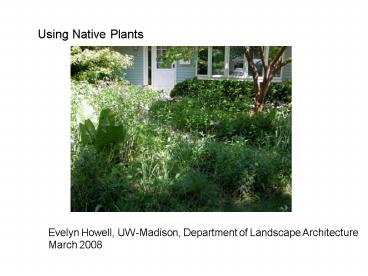Using Native Plants PowerPoint PPT Presentation
1 / 41
Title: Using Native Plants
1
Using Native Plants
Evelyn Howell, UW-Madison, Department of
Landscape Architecture March 2008
2
Topics What are Native Plants? Why use them in
garden design? Natural Landscaping Design Imp
lementation Management
3
Native Plants Plants that are present due to
forces other than direct or indirect human
action. Evolved in communities, not under
cultivation.
Yellow Coneflower
Pasque Flower
Maidenhair FErn
Bloodroot
4
Exotics Species from other places (Europe,
Asia) introduced to the area after Euro-Yankee
settlement.Naturalized Species exotic species
able to grow and reproduce without active
cultivation or care
5
Wisconsin has hundreds of native plants, some
with wide environmental tolerances, others quite
specialized.Habitats range from dry sand to
peat moss
6
Why use them in garden design?Some reasons from
a survey of shelter magazines in the early 1900s
(Dave Egan), most of which still resonate
today Expressive of Regions
Different/Novel Conservation--of the species,
and now of ecosystem processes(biodiversity,
nutrient and water cycles) Patriotism
Aesthetics
7
Natives represent a wide array of colors,
heights, forms, and textures
8
(No Transcript)
9
Natural Landscaping
The use of native plants in community-like
groupings in the built environment
10
Native species are usedPlants are allowed to
take their own formPlanting beds have irregular
shapes (often curvilinear)Both seasonal and
year-to-year changes are celebratedOrder and
aesthetic appreciation come from ARTISTIC DESIGN
RULES and a Design Concept inspired by
thestructure, composition, and functions of the
natural communities used as models
11
Design rules are conventions that organize space
and/or elicit emotionsUse Tools Line, Color,
Form, Texture, Dynamics
12
DESIGN CONCEPTThe Design Concept is the theme
or metaphor or Big Idea that guides the layout,
composition, organization and imagery of the
design
13
NATURAL LANDCAPING DESIGN CONCEPTS COME
FROMEcological Understanding Nature
Immersion
14
PRINCIPLES OF ECOLOGICAL COMPOSITION AND
STRUCTURE Include species that represent
ecological roles Blooming times Active growth
periods Pollination/dispersal mechanisms Growth
strategies--annual/perennial slow/fast
establishment Include appropriate life forms
(Trees, herbs, vines, graminoids, etc)
15
A few species should be abundant the majority
should be relatively sparse.Horizontal and
vertical patterns of growth should be
replicated Aggregations vs. random
placements Solitary individuals vs. clumps
16
Immersion
17
AESTHETIC INVENTORYDate ________________________
_________ Time of Day_____
Approximate Stand Size 1-40 acres 40 acresStand/Community
Type ____________________________________________
_______________Temperature _____________________
_____ Sky Condition________PART 1
REPRESENTATIVE SETTINGFind a location which you
feel represents the community. Sit down and
briefly, in one or two paragraphs, describe your
initial reaction or perception of the aesthetic
community based on observations during your
walk.On page 2 sketch one or more "scenes"
bringing out any other components that you feel
significantly enhance, detract or have a
negligible effect on the "aesthetic quality" of
the community. Components such as sound that are
not easily sketched may be noted. Significant
visible components of the community may also be
highlighted with notes and labels on the sketch.
Sketches should be a composite of your
observations and not necessarily one specific
scene.
18
There was a magnificent display of shooting stars
as well as blue-eyed grass. I found this
community very pleasant because of the low plants
and openness. It was breezy, which made it seem
fresh.It was overall a nice place for
relaxing.This wide open community was pleasant
to be in with absolutely no canopy of any type.
The grasses and forbs were different shades of
green giving an effect of a woven, textured
carpet.
19
(No Transcript)
20
(No Transcript)
21
(No Transcript)
22
(No Transcript)
23
(No Transcript)
24
(No Transcript)
25
(No Transcript)
26
(No Transcript)
27
Example of concept carried out in a variety of
materials and forms Prairie School of Design
- Frank Lloyd Wright
Jens Jensen
28
Of course the garden does not attempt to
reproduce literally the broad, treeless prairie.
No garden can do that because it would require
too great a scale. It merely symbolizes. The
open part or lawn suggests the freedom and
flatness of the prairie the irregular border of
trees suggests the woods that line every river.
The garden does not attempt to portray the
cottonwood-lined rivers of Nebraska or any other
type of prairie. The case is analogous to
program music. Beethoven in his Pastoral
Symphony did not try to imitate a storm. Music
cannot do that, but music can arouse in us the
emotions we have during a storm. Wilhelm
Miller
29
Prairie River Columbus Park
30
Prairie Architecture Frank Lloyd Wright
31
Nature-Inspired Stained Glass Frank Lloyd
Wright Water Lilies
32
Nature-Inspired Stained Glass Frank Lloyd
Wright Autumn Sumac
33
Prairie Design Concept Vista
- Used in relatively large spaces meant to be
viewed from a distance - Use only a few species, but with a range of bloom
times - Use 90 grass plants for every 10 forb plants
- Arrange forbs in monospecific groups -- drifts
34
Prairie Design Concept Vista
35
(No Transcript)
36
(No Transcript)
37
Prairie Design Concept Close-Up
- At least twice as many species as Vista Model
- 50 to 70 grasses 30 - 50 forbs
- Choose forbs so that 1/4 bloom in spring, 1/2 in
summer, 1/4 in fall - Choose at east 1 species from the leading
Families
38
Prairie Design Concept Close-Up
39
(No Transcript)
40
(No Transcript)
41
(No Transcript)

